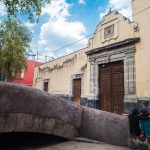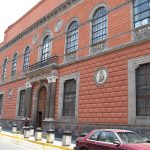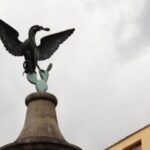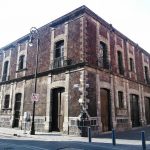
_
The Templo de Jesús María stands out today primarily for the number of religious statues that line the street to which the old convent lends its name. The statues today provide a makeshift atrium along the street. Enthusiasts will recognize it as a convent for the double entry-ways along that street. These are attributed to Manuel Tolsá. Each one is topped by a shield with an eagle and a serpent and the royal crown.
Founded as the Convento Real de Jesús María y Nuestra Señora de la Merced in 1578, by tradition an illegitimate daughter of Philip II, Micaela de los Ángeles, is said to have been interred here. The same legends sometimes mention that she died here, insane, before her 17th birthday. There’s no question, some descendants of the Spanish conquistadors came to live here. The convent was primarily for women lacking a dowry sufficient to make a profitable marriage. Support from the Spanish crown came to support the need for housing and religious instruction of these women not expected to marry.
The royal convent moved to this location in 1582. Construction began in 1597 and the temple was consecrated in 1621. Annexations brought in several adjoining buildings and construction continued until 1673. The architect Alonso Martínez López, the master builder of the Cathedral, was involved with some of these early works. In 1721, Pedro de Arrieta replaced the wooden roof with vaulted ceilings. The current cloister was completed in 1775. Extensive renovations between 1802 and 1812 gave the church the current NeoClassical style. Architect José Antonio González Velázquez carried out this work on the facades, the dome and the choir loft.
With the Reform Laws, the sisters were ex-claustrated in 1861. 29 of them arrived at the Regina Coeli convent. They briefly tried to reclaim the convent during the French intervention but were removed again with the restoration of the Republic. In 1874, the property was divided and some of it ceded to the government. The temple was declared a historical monument in 1931. It only reopened as a church in 1961, being heavily restored for that purpose.
As a convent, it’s remember today as one of the largest, richest, and best decorated. The mosaic-covered dome and 17 stained glass windows attest to this. Several altars and baroque altarpieces were lost after 1861. An image of the “Lord of Love,” a particularly young Christ, is believed to be unique in the archdiocese. Devotees are said to come from Hidalgo, Tlaxcala, Puebla and the State of Mexico on February 14, at noon, to celebrate a mass in honor of this particular aspect of Christ.
But visitors taking a peek inside the Templo de Jesús María are richly rewarded. Many unique art works, and the obvious panorama of a rich past are apparent in nearly every corner.
 55 5522 8591
55 5522 8591

Nearest at 0.12 kms.

Nearest at 0.12 kms.

Nearest at 0.16 kms.

The first Academy and Museum of Fine Arts in the Americas...

A legendary plaza in the Barrio Merced...

One of the most historically relevant cultural centers in the Historic Center...

A former grain warehouse on the Banks of the Royal Canal.